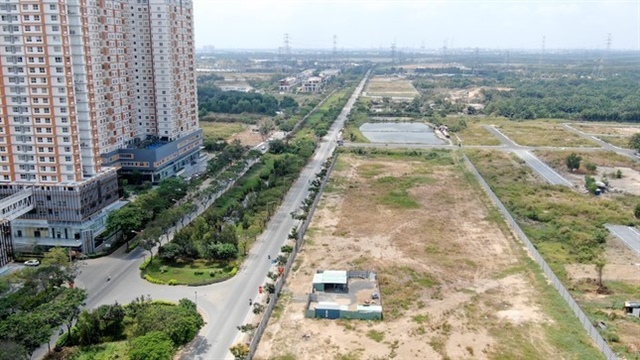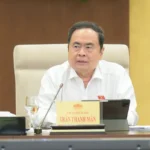At a press conference on June 26 providing information on socio-economic issues in Ho Chi Minh City, Mr. Nguyen Kien Giang, Deputy Head of the Department of Construction Management and Exploitation under the Ho Chi Minh City Department of Construction, announced a pilot program to waive construction permits. This program aims to facilitate and reduce administrative procedures and travel time for residents initiating construction projects in the city after the provincial government merger.
According to Mr. Giang, the technical and legal requirements for permit exemption are based on Article 89, Clause 2 of the 2014 Law on Construction. This applies to detached houses with less than seven floors within an approved urban area development project or a residential construction project with a detailed 1/500 plan approved by authorized state agencies.
The design and construction of detached houses follow the regulations stated in Article 79, Clause 7 of the 2014 Law on Construction. The construction process for households and individuals is outlined in Clauses 3, 4, and 5 of Article 9 of the Government’s Decree 06/2021.
In response to the Prime Minister’s Official Dispatch No. 78/2025 on focusing on reducing and simplifying administrative procedures in the construction sector, the Ho Chi Minh City Department of Construction has collaborated with districts 6, 7, 8, and 12, as well as Binh Tan, Tan Phu, Can Gio, Hoc Mon, Nha Be, and Thu Duc City, to review residential projects with detailed 1/500 plans.
On July 1, the Department of Construction plans to announce the projects that have detailed 1/500 plans or urban designs approved by authorized state agencies and are eligible for construction permit exemptions.
 The pilot program to waive construction permits aims to reduce red tape and convenience for residents. |
The areas with the highest concentration of lots exempt from permits are in District 7 and Nha Be, Binh Chanh, and Thu Duc districts.
In cases where a permit is not required, residents must submit a construction commencement notification to the People’s Committee of the commune where the construction takes place, at least seven working days before the commencement of construction. Mr. Giang noted that this notification must be accompanied by certified copies of legal land documents and designs that adhere to the specified architectural and planning criteria.
Regarding construction supervision, Mr. Giang referred to Clause 3, Article 26 of the 2025 Law on Local Government Organization, which authorizes the chairman of the ward-level People’s Committee to inspect compliance with the law in the construction of houses and urban construction works as stipulated by law.
Additionally, according to Clause 12, Article 7 of Circular No. 10/2025 of the Ministry of Construction, which guides the functions, tasks, and powers of specialized agencies under the People’s Committees of provinces and centrally-run cities in the construction field, the Department of Urban Economic Infrastructure is responsible for inspecting the construction of works according to the regulations on architectural management, urban planning, and design. They also ensure the publication of approved planning schemes.
Previously, Mr. Huynh Thanh Khiet, Deputy Director of the Ho Chi Minh City Department of Construction, shared that the department is focusing on reviewing and streamlining planning processes, with a priority given to delegating permitting authority.
The Government has issued Decree No. 140/2025/ND-CP, which defines the division of authority between the two levels of local government in the field of state administration under the Ministry of Construction.
The authority to grant construction permits for detached houses and Grade III and IV projects will be transferred from the district level to the ward level People’s Committees.
Regarding the waiver of construction permits, Mr. Khiet mentioned that the Ho Chi Minh City Department of Construction is coordinating with the People’s Committees of districts, rural districts, and Thu Duc City to review and compile a list of areas that meet the requirements for permit exemption.
These areas have detailed 1/500 scale plans and meet all technical and legal requirements. In such cases, residents are only required to notify the commencement of construction instead of obtaining a permit.
However, Mr. Khiet pointed out that eliminating the permit requirement also presents new management challenges. Functional units need to closely coordinate construction supervision, handle disputes, and update assets after the completion of the project.
Currently, Ho Chi Minh City has approximately 360 areas with about 55,000 lots that meet the conditions for construction permit exemption.
The Ho Chi Minh City Department of Construction is expediting the process of gathering feedback from local authorities on the list of areas eligible for permit exemption. They aim to finalize and submit the list to the Ho Chi Minh City People’s Committee for review and decision before July 1, 2025.
Duy Quang
– 11:50 27/06/2025
Discover the Luxury Pocket Spring Mattress Collection at Vietbuild 2025
From June 25 to 29, 2025, the Vietbuild International Exhibition in Ho Chi Minh City made its grand return for the first time this year at the Sky Expo Center. Uuviet Solutions’ booth once again became a magnet for visitors, showcasing the premium Dream Master pocket spring mattress range.
Transforming Land Use: Fees Surge by 300%
The new land pricing policy has resulted in a significant increase in taxes for those wishing to change their land usage. With a 250-300% surge in taxes for converting agricultural land to residential use, many are now facing financial difficulties due to the substantial rise in costs.
A Seamless Journey: Avoiding the 5-Hour Tan Son Nhat – Long Thanh Transit Travesty
“The Long Thanh International Airport risks falling short of its potential as a regional development catalyst if its infrastructure lags behind. A disjointed connection to Ho Chi Minh City could hinder the airport’s operations, relegating it to merely a transportation hub rather than a dynamic growth engine.”





















